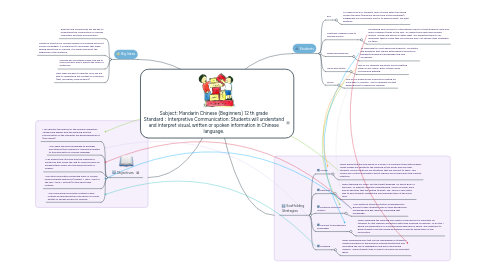
1. Big Ideas
1.1. Radicals and components are the key to understand the composition of Chinese characters and their pronunciation.
1.2. Sentence structure in Chinese differs from English and most Roman Languages. It is important to remember that when talking about time in Chinese, it is always placed at the beginning of the sentence.
1.3. Chinese has something called "the big to small principle" and it affects the order of sentences.
1.4. Main ideas are easy to identify once we are able to understand the context of a situation (text, recording, visual product)
2. Objectives
2.1. I can identify the radicals of the Chinese characters studied and explain how the meaning and the pronunciation of the character are being defined by it (the radical).
2.2. I can apply previous knowledge to decipher and interpret the meaning of new words related to time and dates in Chinese language.
2.3. I can analyze the structure and the meaning of sentences that follow the "big to small principle" by breaking them down into the different parts of speech.
2.4. I can retell information presented orally or visually using complete sentences (subject + date + part of the day + time + activity) to talk about daily routines.
2.5. I can summarize information related to daily routines by identifying the main ideas of a visual, written or spoken product in Chinese.
3. Students
3.1. ESL
3.1.1. To support my ESL students, who at some extent are doing double the work (learning a second and a third language) I exaggerate my movements and try to express what I say with gestures
3.2. Low/basic readiness due to missing lessons
3.2.1. Something very common in International schools is that students come and leave a different times of the year. To support hose who have missed lessons I model and explain in detail what I am expecting them to do. Whenever there is a gap they let me know and I can design other strategies for them
3.3. Advanced readiness
3.3.1. To challenge my most advanced students I constantly ask questions that require establishing connections between background knowledge and new vocabulary.
3.4. Visual and artistic
3.4.1. Two of my students are artists and are getting ready for art school. Both of them enjoy coloring and drawing.
3.5. ADHD
3.5.1. One of my students has a hard time seating for more than 15 minutes. I try to integrate content within games to support his learning.
4. Scaffolding Strategies
4.1. Visuals
4.1.1. When presenting the new words of a lesson I accompany those with images. These images are related to the meaning of the words and also help students connect with real life situations that are relevant to them. This visuals also contain information about radicals and components that support retention.
4.2. Gestures
4.2.1. When teaching my class I use the target language for about 80% of the class. To support students understanding I move my body, arms and do gestures that are related to what I say. This is a very useful way to help students understand and challenge them at the same time.
4.3. Sentence structure starters
4.3.1. I use sentence structure starters embedded into games to help students recall on their background knowledge and get ready for expanding that knowledge.
4.4. Connect to background knowledge
4.4.1. When explaining the meaning and usage of new words it is important for students to start making connections with their acquired vocabulary. To do this I based my explanations on a inquiry based approach in which I ask questions to guide students find the meanings instead of directly giving them all the information.
4.5. Modeling
4.5.1. When developing skills that can be challenging for students I model procedures in the board by using projected text and simulating the use of highlighters and pens using board markers. I show students tips on how to find and use important ideas.

